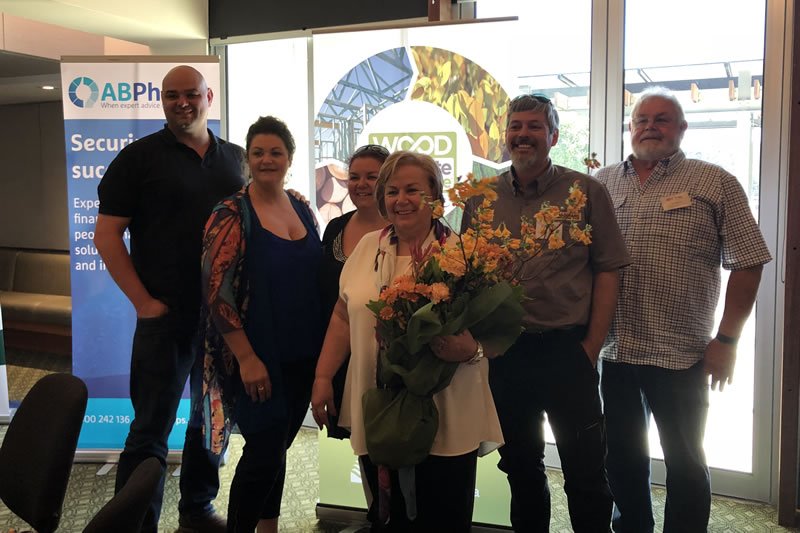The annual MGA TMA lunch saw several experts talk on major industry issues.
There is only one downside to the annual MGA TMA lunch: it isn’t long enough to talk with all the brilliant people in the room as well as hear all the speakers, and so business cards were swapped before and after the set of thought-provoking talks.
MGA TMA president Peter Alexander opened proceedings. He welcomed Gary Blackwood, Victoria’s Assistant Shadow Minister of Forestry, and other major industry advocates in the room, including Jos de Bruin, CEO of MGA TMA, and Peter Strong, CEO of the Council of Small Businesses of Australia (COSBOA).
Strong joked that living in the ACT made it easier to have his voice heard in Parliament House: “I know all the security guards and they know my dogs, because you meet everyone in the parks in Canberra!”
More seriously, he flagged that it was only through cooperation that small enterprises were able to counter the voice big businesses command when it comes to influencing government. De Bruin agreed, pointing out that many decisions were made without consulting small businesspeople, who form the backbone of the economy.
Alexander spoke on similar lines, though with optimism. “The TMA’s never been in a better position than it is at the moment as far as advocacy is concerned,” he said.
Echoing Strong, he emphasised that cooperation was the key. Alexander said: “I was talking to Gary earlier and I said that we hadn’t had this sort of opportunity before; we’d always been a sort of fractured industry. Now we have an opportunity to leverage this new-found strength.”
Alexander encouraged members to use the MGA TMA’s day-to-day services to help with the running of their enterprises, but also to get involved in broader policy work.
Ann Sanfey, national membership manager for MGA TMA spoke next on programs and the strength the amalgamation of TMA with MGA has brought. New offerings including the technical advisory service, safety management program with onsite auditing and additional training programs (including online options) were highlighted.
Sanfey recommended members visit the website for a range of forms and policies that are available for use, and spoke of the annual Frederick Richard O’Connell Scholarship, which supports the children of timber industry employees. She also discussed the legal resources available through MGA TMA, and how members can benefit from the legal team’s industry expertise.
Finally, she called for members to get involved with the organisation’s lobbying on wages, which is its next big campaign.
Ultimate renewable
Eileen Newbury from FWPA talked about The Ultimate Renewable campaign, which has been running across Australia.
Newbury explained how old ideas of deforestation had held the industry back in the public and media perception. Over the past 18 months, FWPA has been working to reframe that message, based on detailed analysis of the market, media and audience.
Contradictory ideas held by many were listed: we love wood, but don’t want to cut down trees. We care about the environment but aren’t prepared to do or pay much for it.
FWPA’s approach was to focus on forests and the cyclical and increasingly sophisticated nature of tree harvesting, leading to the tag line of The Ultimate Renewable.
As well as a significant spend on ad space, the logo has been splashed across haulage vehicle curtains, on industry banner ads, invoices and stationery as a way of spreading the message. Newbury said the size of promotional spend is small compared to steel and brick, but focusing on carbon storage and sustainability is a clever cut-through with consumers.
“We wanted to impact, inform and inspire,” she says, and the reach of the campaign has achieved just that. “Our research indicates one in five Australians has seen the TV commercial, one in four recalled seeing either the TV ad or outdoor billboard, and there were positive attitudes to the message in the general public… 67% of people claim that seeing the campaign has made them more supportive of forestry.”
A new Ultimate Renewable website is coming, and an online merchandise store. Co-branding opportunities are also available. “If we all work together, we’ll achieve what we want to,” Newbury concluded.
Economics, fire and thanks
Brien McDonald, NAB senior economist in industrial and behavioural economics was the next speaker. He opened with a disclaimer, “Trust meteorologists rather than us for forecasts,” before talking the economic outlook. In general terms, things are slow at the moment, with manufacturing low but services still doing well. Business confidence is down on average and profitability is being squeezed, particularly in the retail sector. Construction has also fallen considerably over the past 18 months.
In good news, non-residential building is still strong, ie construction related to infrastructure. Current rate cuts are delivering “more bang for your buck” than tax cuts, as tax cuts mostly go into paying down debt or savings rather than purchases.
Retail isn’t entirely down: hardware, building and garden supplies have areas of real growth. And while house prices dropped, many are rebounding and they’re still well up over five years. McDonald suggested figures were optimistic two years out.
Boris Iskra from Wood Products Victoria was the last speaker of the day. One focus of his speech was the recent shift by regulators to interpret the use of timber cladding on the outside of three-storey and higher single-exit commercial buildings as unacceptable.
A formal amendment to the code went out for public comment, and FWPA, where Iskra also works, was one of the many groups to submit comment. Results are pending.
In the meantime, industry is developing a performance solution with fire engineers, and a CodeMark approval process is also being investigated. Neither alternative is quick or cheap, but they would involve marketplace acceptance for the timber product – which has had decades of safe use.
Iskra emphasised the importance of looking at a building as a whole system, including windows, doors, roofing and plaster to achieve a fire-rated structure (see page 20 for more). “The only thing I would flag with designers is, if you build a timber-clad wall on a tight boundary, how do you maintain it? Timber’s not going to last forever.”
Finally, two longstanding committee members who are retiring were thanked for their years of hard work. Myriam Webster of DeMar Hardware said, “I encourage anyone thinking about sitting on the committee to do so, especially females, because for a long time I was the only one.”
Ron Caddy of Lamcal Timber said he had been happy to go in boots and all, reminding the audience, “Around the 2000s the TMA got into a bit of strife and there were a group of stalwarts holding it all together through really difficult times: Peter Alexander, Richard Hill, Myriam Webster and Clive Dossetor were the main four…and we owe it all to them.” He admitted he had been hesitant about the union with MGA – “we’re not happy to deal with grocers!” – but in fact the union well worked due to shared core values and has represented “much better leverage for the industry”.
Mark Palladino, who had smoothly compered the event closed by thanking corporate partners AB Phillips, Flexible Capital, First Super, NAB, Eftpos, Aussie NRG and OneFortyOne.
Image: Myriam Webster with her colleagues and husband Alan (right).











